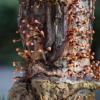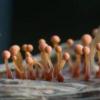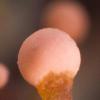
29-12-2025 10:15
Hulda Caroline HolteHello, I found and collected this propoloid ascom

29-12-2025 09:38
Oskari VirtanenHi,could anyone help me identify this, I suspect P

29-12-2025 08:30
Hello.A tiny ascomycete sprouting under Juniperus

28-12-2025 12:08
Margot en Geert VullingsThis possible Karstenia was found on the bark of d

21-12-2025 21:32
Pol DebaenstHello, Garden, Burgweg 19, Veurne, BelgiumOn 10/1

26-12-2025 21:19
Arnold BüschlenPithyella chalaudii Priou. Ist als Bryoparasit in

21-12-2025 09:32
Hello.A tiny ascomycete found embedded in wood in

18-12-2025 21:17
Pol DebaenstThe identification took me to Byssonectria deformi
 Hello Ascofrance!
Hello Ascofrance!I have come across two potential names for this fungus, collected in Andean cloud forest between 2500 and 2950 m.a.s.l. outside of Medellin, Colombia. It has also been observed in Costa Rica at ~600 m.a.s.l., and at least one other locale that I am aware of. It is seen here on some dead, herbacious stem. A very, very similar fungus is tentatively named Chardonia rosea in a color figure on page 143 of Meike Piepenbring's Introduction to Mycology in the Tropics, while this pdf from Funga Veracruzana:
http://fungavera.com/fungavera/funga%20pdf/121-TUBERCULATE.pdf
calls it Tubercularia lateritia. I am here to find out if this fungus should be called either or neither of these names. Sadly, there is no microscopy, so I understand if no advice can be offered. Perhaps the species is sufficiently recognizable to the naked eye to be identified, if only to genus.
Final note: this post is mirrored at Mushroom Observer at the following link:
http://mushroomobserver.org/189147
Many thanks in advance for your contributions.
-Danny

your fungus could be Nectria pseudotrichia asexual state = Tubercularia lateritia.
It is the most common species in subtropical and tropical regions.
Regards,
Christian



